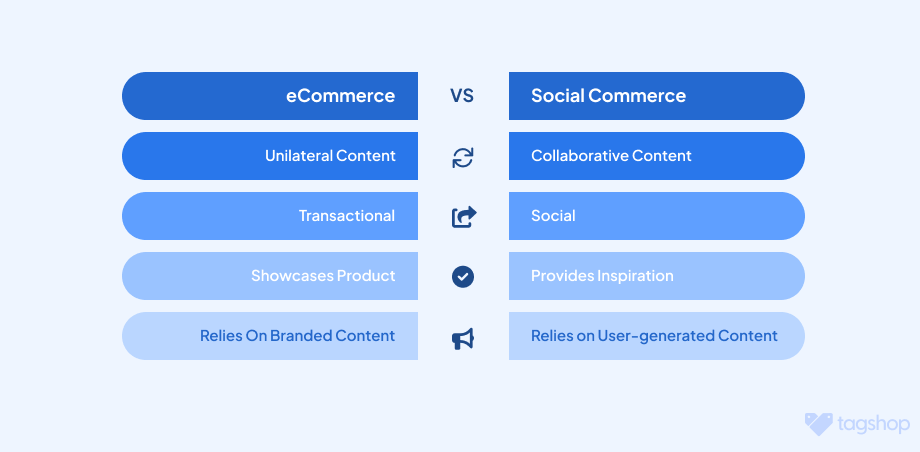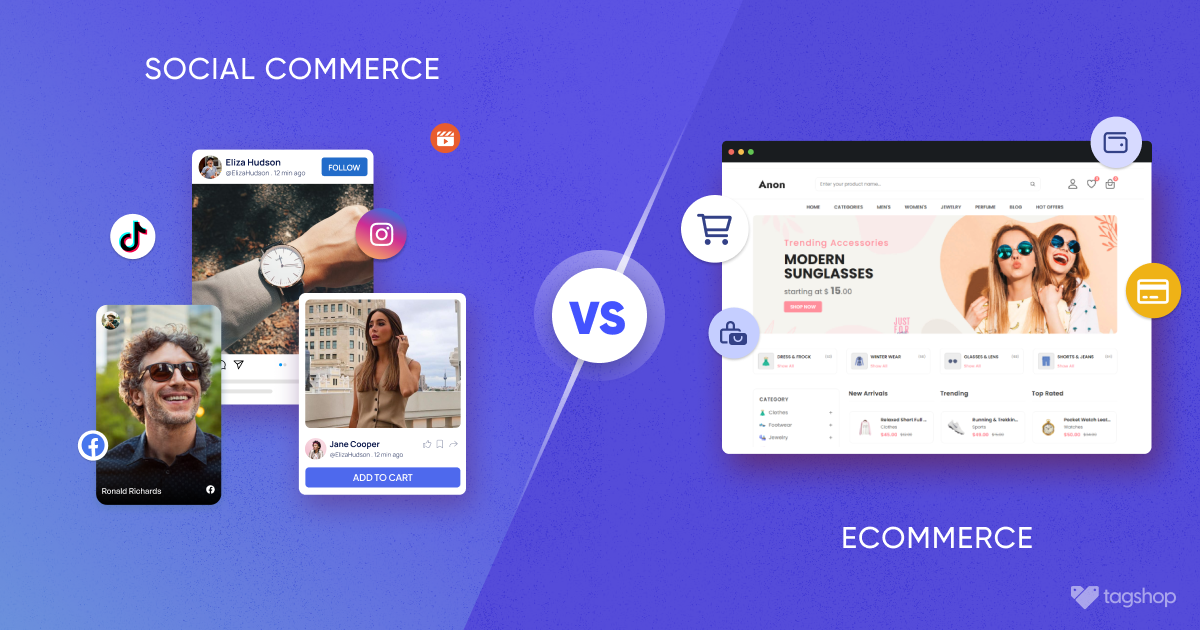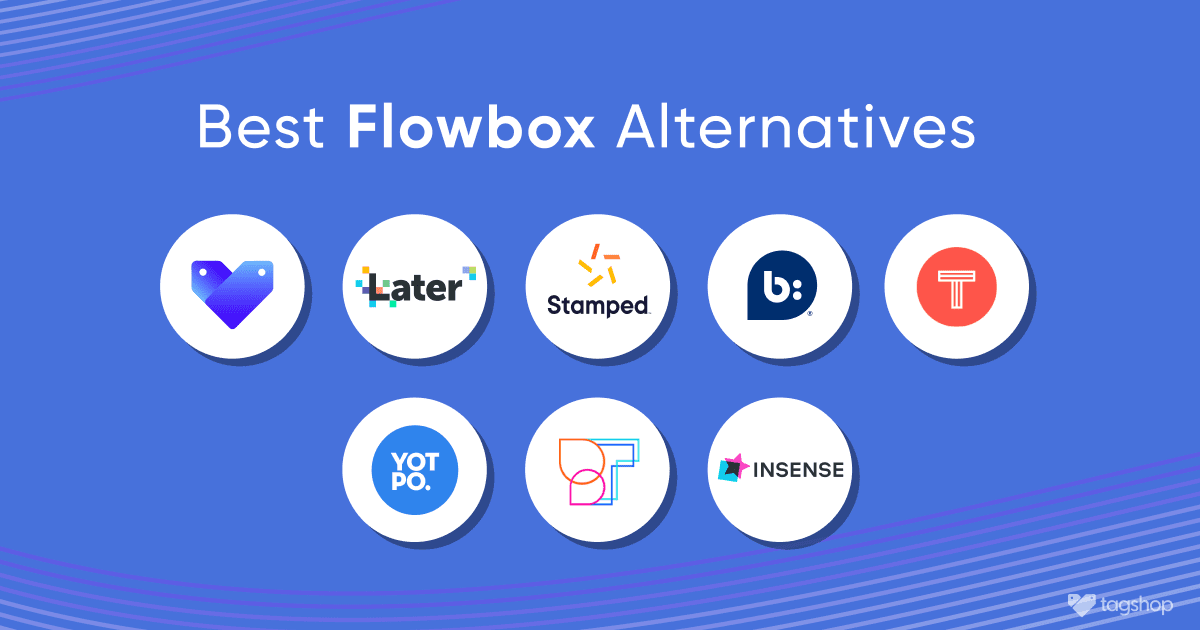Social Commerce vs. eCommerce: A Comprehensive Comparison for eCommerce Businesses
You’ve probably read this way too many times by now. The entire marketing world is talking about it. And we are, too!
eCommerce is changing. Period.
But what’s important here is that it is not just changing in a way that it’s growing or making a mark. But it’s also changing in a way that it has a whole new subset to it, and now that subset, called Social Commerce, has become a whole entity in itself.
In this discussion of Social Commerce vs. eCommerce, did you know statistically, social commerce is expected to grow three times as fast as traditional e-commerce to $1.2 trillion by 2025, up from $492 billion currently.
Isn’t that something to really ponder upon? There’s a lot in the bag about this term. However, what does it really mean in definition?
Definition of Social Commerce
Simply defined, social commerce is the process of selling products on an eCommerce platform via social content. This seamless blend of eCommerce and social media allows eCommerce businesses to leverage content from social media platforms. This practice allows consumers to take direct action on it, like making a purchase, and businesses to generate direct sales from it.

This seamless integration is a game-changing strategy for eCommerce businesses looking to make use of their online presence and grow revenue.
However, that’s not all. Social commerce may or may not take place on an eCommerce platform. While its intention is always transactional, social commerce can also be a part of other marketing tactics like email marketing campaigns and social media.
Ready to Explore the Future of Shopping?
Discover the Possibility of Social Commerce in eCommerce!
Try For FreeIntroduction to eCommerce
By definition, eCommerce refers to the process of buying or selling products or services online over a dedicated website or store. It is a virtual storefront where businesses can showcase their products, and consumers can shop seamlessly.
Businesses provide other amenities like on-deliver payments, one-day delivery, and the use of magic links for seamless user authentication to make their consumers’ shopping experience feel less virtual and frictionless.
However, these amenities also depend greatly upon different types of eCommerce.
1. Business-to-business (B2B)
B2B eCommerce refers to the exchange of products and services between businesses. This type of e-commerce model usually caters to manufacturers and wholesalers that cater to retailers and provide them with items in bulk.
This type of e-commerce is also one of the most active e-commerce models and is expected to reach $3 trillion dollars in the US by 2027.
2. Business To Consumer (B2C)
B2C eCommerce refers to a type of eCommerce where businesses sell products or services directly to consumers. This is the most common type of e-commerce model and caters to both buyers and sellers. Moreover, understanding the difference between D2C vs B2C is crucial, it’s essential to consider the direct relationship between brands and consumers in the D2C model, which bypasses traditional retail channels.
In this model, businesses showcase products on their digital storefront or website and allow consumers to purchase directly from the website. B2C e-commerce is estimated to grow at a compound annual growth rate (CAGR) of 7.6% between 2022 and 2030.
3. Consumer To Consumer (C2C)
Another interesting e-commerce model is Consumer-To-Consumer. In this model, consumers sell products or offer services to consumers. Some examples of this type of e-commerce include C2C platforms like eBay, Etsy, and OLX. Some other C2C examples may also include online auctions or payment platforms such as PayPal and Zelle.
This e-commerce model is solely built on transactions between individuals. Statistically, the global C2C community is expected to grow at a CAGR of 6.2%
4. Consumer To Business (C2B)
C2B or Consumer-To-Business refers to a type of e-commerce where consumers make their products or services available for businesses. This type of e-commerce can be justified through examples like a home-baker selling their bakery products to cafes.
More so, there are various C2B e-commerce platforms like iStock, where freelance designers can upload their designs and make them sellable to businesses.
With that, we have covered all types of e-commerce models present. We are sure that by now, you know how significant this industry has become. And this doesn’t stop here.
As e-commerce continues to evolve, various new models and subsets of e-commerce are emerging. Social commerce, for one, is becoming the new e-commerce integration that businesses are choosing.
Now, let’s move forward and understand more about Social Commerce vs. eCommerce and the similarities between these intermingled terms – eCommerce and Social Commerce.
Don’t Miss Out on Sales Opportunities
Learn How to Integrate Social Commerce into Your eCommerce Strategy Today!
Book Demo
Similarities Between Social Commerce And E-Commerce
Social commerce and e-commerce are like two peas in a pod. They are both individual terms but share various similarities.
Let’s find out about these similarities in detail:
1. Takes Place Over A Digital Storefront
First things first. Both social commerce and e-commerce take place on a digital storefront where businesses can lay out their products in a visually appealing way, and consumers can shop them from the same storefront.
This similarity is also the most crucial one as it defines what modern e-commerce stands for – meeting your consumers where they are rather than having them make the effort to reach you.
2. Simplified Purchases
While the process of reaching the checkout window might differ, both e-commerce and social commerce facilitate simple purchasing processes. Users can explore products, add them to cart, and make purchases through a plethora of payment options such as digital payments, card payments, or cash on delivery.
3. Product Listings
Product listing is an integral part of any business, be it e-commerce or retail. A product listing is a description or portfolio of products with details that help the consumers to make informed purchasing decisions.
Both e-commerce and social commerce feature product listicles that showcase the products available for purchase.
4. Can Be Scaled Globally
Both social commerce and e-commerce have the ability to reach a much wider audience organically. Both types of businesses can make use of marketing tactics, such as influencer marketing and email marketing, and promote their offerings more effectively.
According to statistics, over 28% of the global population shops online. Which proves the scalability and growth possibilities of social commerce and e-commerce.
Ready to Boost Your Ecommerce Sales?
Find Out How Social Commerce Could Be Your Secret Weapon!
Explore Now
5. Makes Shopping Convenient
Another positive similarity between social commerce and e-commerce is that both make shopping highly convenient for customers.
Customers can explore products on the online store from anywhere in the world and purchase them without any geographical barriers. This convenience is the most important reason why e-commerce businesses are flourishing.
Despite these similarities, there are also significant differences between social commerce and e-commerce to keep our discussion about Social Commerce vs. eCommerce open. While eCommerce refers to the process of buying or selling products or services online over a dedicated website or store. Social commerce is a way of shopping online through social media content integrated into the eCommerce website.
Differences Between Social Commerce And E-Commerce

These similarities between social commerce and e-commerce prove that both the terms are related to each other in more ways than you might have anticipated earlier.
However, they still have key differences that set them apart. In this section, we shall uncover them for you.
1. Uses Different Forms Of Content
One major difference between social commerce and e-commerce is that e-commerce relies solely on branded and pre-shot content to showcase their products. This type of content usually includes static images, textual product descriptions, and fabricated content.
On the other hand, social commerce is a more interactive form of shopping where brands use authentic content to showcase their products. This includes shoppable galleries of user-generated content and more focus on interactive video content. This authentic visual content plays a crucial role in showcasing products and inspiring customers.
2. Product Discovery
Product discovery is another aspect where e-commerce and social commerce differ from each other. Finding products is a more prolonged process in e-commerce than in social commerce. It expects customers to find products through methods like searching for products on the platform or browsing through listicles of products to come across what you are looking for.
Contrarily, social commerce is a more frictionless process of product discovery. Brands provide customers with Shop The Look inspirations where customers can directly purchase entire collections from Shoppable UGC Gallery rather than spending time looking for complimentary products.
Start Converting Social Engagement into Sales
Explore the Power of Shoppable Social Media!
Explore Features3. Different Platform Types
Another difference between e-commerce and social commerce is their platform differences. While e-commerce takes place on a dedicated storefront like an online store, website, or e-commerce marketplace like Amazon, social commerce is not confined to it.
Social commerce is more varied in terms of platform type. It can be integrated into an e-commerce website, as a part of email marketing, or even as a shoppable social bio on your preferred social media platform.
4. Authenticity & Customer Trust
In e-commerce, businesses establish trust through product descriptions, branded images, and customer reviews. While some amount of trust can be built through these forms of content, it may still not be as inherently social as in social commerce.
Social commerce uses more authentic means of content to build customer trust. Social commerce is majorly centered around user-generated content such as compelling visuals and customer testimonials. The social context can enhance trust in products more vividly.
5. Control Of Content
Control of content is one more difference between e-commerce and social commerce. E-commerce makes use of branded content, generated in-house to showcase products and indulge in promotions. This ownership of content makes it easier for businesses to advertise themselves at various touchpoints.
Social commerce inherently uses authentically created UGC, which is practically not owned by the business. This lack of ownership reduces the control of content unless the business has gained content rights from the user.
These differences highlight how social commerce and e-commerce follow different approaches to present their products.
Social commerce is based on user-generated content, and the influence of social media platforms for product discovery and sales, while e-commerce focuses on branded content and structured product catalogs.
Now, let’s understand how these two can come together to create a profitable business.
Learn How Top Ecommerce Brands Leverage Social Commerce for Explosive Growth
Get Started Today
Explore For FreeSocial Commerce Integration Strategies for E-commerce Businesses
Integrating social commerce into your e-commerce business is the best strategy to improve your revenue in 2023. By taking advantage of this strategy, businesses can not only make a mark among customers but also surpass their competitors.
Let’s learn some effective strategies to integrate social commerce for your e-commerce business.
1. Stay Active On Social Media
Your strategy to integrate social commerce into your marketing efforts depends greatly upon how well you are present on social media. One thing about social commerce is that it is backed solely by social content.
So the first step towards planning this integration is to improve your social media presence and engage with your audience. Social media is a great way to build an audience and once you start paying attention to your audience, they will give you back in terms of social proof like reviews, ratings and other forms of social content.
2. Incorporate User-Generated Content
As mentioned various times in the sections above, user-generated content is the most diligent form of content while working to integrate social commerce for your e-commerce business.
By utilizing existing user-generated content into you e-commerce, you can establish trust among your customers, make your e-commerce look more genuine and authentic. Not just that, you can also encourage more customers to create content for your business, making it easier for your business to create shoppable UGC galleries.
3. Invest In A Social Commerce Platform
Another effective strategy to integrate social commerce for your business is to invest in a suitable social commerce platform. There are various social commerce tools and platforms available in the market that can cater to your business’s specific requirements.
Tagshop is a top social commerce platform that enables e-commerce businesses to seamlessly collect content from social platforms like Instagram and curate compelling shoppable galleries. With Tagshop, businesses can not only integrate social commerce into their e-commerce website but also run effective shoppable email marketing campaigns.
4. Launch A Branded Hashtag
An important factor in making your social commerce strategy effective is to have enough social proof and user-generated content from your customers. And to do that, one great strategy is to launch a fun branded hashtag with a good recall value.
You can encourage your customers to create content using the hashtag. This practice can be highly beneficial in improving your brand’s value and can help you collect quality content to integrate into your e-commerce storefront.
5. Focus On Influencer Partnerships
Influencers can significantly improve your brand’s awareness and engagement, which can directly result in increased revenue for your brand. To effectively use this strategy, find influencers that match your niche and collaborate with them to drive quality content that can be used in your e-commerce or other marketing efforts. You can use delivery route planning software to send products and create content for your e-commerce store.
An effective social commerce integration requires a well-thought-out combination of strategies such as creative content, engagement with your audience, and data-driven decision-making.
Social commerce is dynamic, so staying current with trends and platform updates can be the best way to success.
Choosing the Right Path for Your E-commerce Business
When it comes to choosing the right path for your e-commerce business, there is not one but various factors that contribute to it. The e-commerce industry is growing exponentially, and each business has its own needs and requirements depending upon factors like target audience, if the business is small scale or well-established, or if it’s a hybrid setup (with retail stones as well) or an online business.
If we look at statistics, 70% of millennials and 78% of Gen Zers in the UK buy directly from social content.
Isn’t that interesting?
Consumers are becoming more inclined towards social. Which is why it is important to build and maintain strong customer relationships by focusing on integrating strategies that can keep customers coming back.
Discover Which Strategy Aligns Best with Your Ecommerce Goals
Social Commerce or Traditional Ecommerce?
Book Free DemoConclusion
In conclusion, the relationship between social commerce vs. eCommerce is pretty intermingled. Both have a range of similarities that make them highly related to each other, and their differences are what makes both the approaches unique.
While social commerce is growing at a great pace, it is important to note that success lies in understanding your customers and their ever-changing preferences while providing a seamless and satisfying shopping experience for them.
Frequently Asked Questions
What is the fundamental difference between Social Commerce and e-commerce?
The fundamental difference between social commerce and e-commerce is their approach to showcase products. While e-commerce is more inclined towards presenting products through branded and professional content, social commerce strives to showcase products through authentic content like user-generated content.
Which approach is more suitable for a small business looking to start selling online: Social Commerce or e-commerce?
Social commerce is a powerful strategy for a small business looking to start selling online. Social commerce integration is a great way to establish customer trust. It uses authentic content from customers to showcase products and therefore, can help the business seem more genuine.
What are the advantages of Social Commerce over traditional e-commerce?
Social commerce is a more effective strategy than e-commerce. Social commerce provides a more personalized shopping experience to customers. It displays UGC to showcase products and helps customers visualize these products in action.
Can an eCommerce business benefit from integrating social commerce strategies?
Integrating social commerce is highly beneficial for e-commerce businesses as it can help the business make good use of its social media presence. Integrating social commerce is also a top-tier way to establish trust among customers and also improves the overall aesthetic of any online store.










